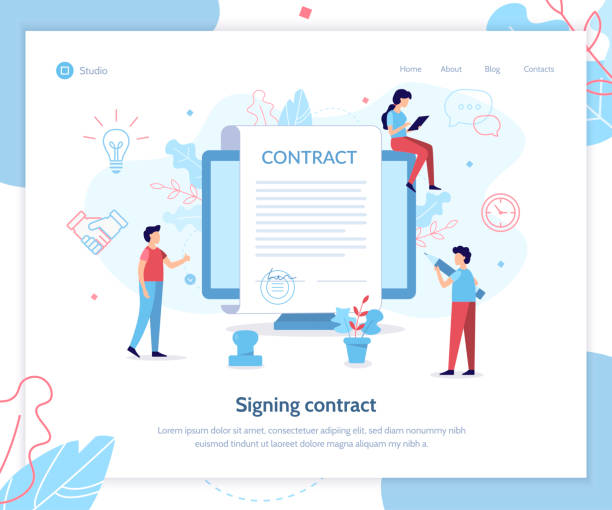Introduction to Fast Website Design, Its Importance and Necessity

In today’s digital world, fast website design is more than a competitive advantage; it’s an indispensable necessity.
Users expect websites to load instantly, and any delay, even a few seconds, can lead to loss of visitors and customers.
This not only negatively impacts #user_experience but can also lower your website’s ranking in search engine results.
The importance of #website_load_speed in attracting and retaining audiences, improving conversion rates, and increasing business revenue is undeniable.
In fact, search engines like Google consider speed a key factor in website ranking and penalize slower websites.
Therefore, investing in fast website design means investing in the digital future of your business.
This process includes a set of technical and strategic measures whose ultimate goal is to reduce the time required to fully display a web page’s content to the user.
In this explanatory section, we examine various aspects of why load speed is so important and how it can affect a website’s overall performance.
We will elaborate on the concept of speed optimization and its main components, demonstrating how a faster website can help achieve your business goals.
The importance of a website’s quick responsiveness to user needs is paramount, not only for e-commerce sites where conversion rates are vital but also for blogs and news sites whose aim is to deliver fast and smooth content.
In summary, understanding and implementing the principles of fast website design is a fundamental step towards online success in today’s competitive environment.
Don’t have a corporate website yet and missing out on online opportunities? With professional corporate website design by Rasawweb,
✅ Double your business’s credibility
✅ Attract new customers
⚡ Free consultation for your corporate website!
Why Website Speed is Crucial for Your Business

Have you ever considered what cost every second of delay in your website’s loading can incur for your business? This is a #thought_provoking and yet analytical content that reminds us that fast website design is no longer an option but a business necessity.
In today’s world, where users browse the internet in a hurry, their patience has significantly decreased.
According to research, many users abandon websites that take more than 3 seconds to load.
This not only leads to an increased #bounce_rate but also directly affects #conversion_rate and ultimately, your revenue.
A slow website provides an unfavorable user experience, which can harm your brand’s reputation.
From an SEO (Search Engine Optimization) perspective, Google and other search engines consider website speed an important factor in page ranking.
Faster websites achieve higher rankings and are more likely to be seen.
This means that if your website is slow, you might rank lower than your competitors in search results, even if you have higher-quality content.
Fast website design helps improve your visibility in search engines and drives more organic traffic to your website.
Furthermore, speed also impacts the efficiency of your advertising campaigns; pages that load quickly have higher click-through rates and lower cost-per-click.
Therefore, investing in website speed_optimization is a direct investment in the growth and success of your business and yields a significant return on investment.
Technical Factors Affecting Fast Website Design Speed

To achieve fast website design, understanding and managing underlying technical factors are of utmost importance.
This specialized section helps you identify the root causes of your website’s slowness and implement appropriate solutions.
One of the most important factors is #optimized_and_clean_coding.
HTML, CSS, and JavaScript codes that are unoptimized or have a large size can significantly increase page load time.
Using minified codes and removing unused code is of particular importance.
The second factor is #image_optimization.
High-quality, large-sized images are one of the most common reasons for website slowness.
Using appropriate formats (such as WebP), compressing images without quality loss, and employing Lazy Loading can have a significant impact on speed.
The third factor is choosing suitable #hosting and proper server configuration.
A slow server or an overloaded shared host can affect your website’s performance.
Using dedicated servers, VPS, or cloud hosting with sufficient resources, as well as correctly configuring the web server (like Nginx or Apache) and database (like MySQL), is essential to ensure fast server response.
The fourth factor is using lightweight and optimized plugins and extensions.
On platforms like WordPress, excessive use of heavy and unnecessary plugins can severely impact website speed.
Proper management of scripts and web fonts is also highly important.
Finally, enabling Gzip compression and utilizing HTTP/2 for data transfer are also important technical factors that help improve the speed of fast website design.
Together, these factors ensure an optimized website with excellent user experience.
| Slowing Factor | Description | Proposed Solution |
|---|---|---|
| High-volume images | Unoptimized images that occupy a lot of space. | Compression, conversion to WebP, Lazy Loading. |
| Uncompressed HTML, CSS, JS code | Large files containing unnecessary characters. | Minification, removal of dead code. |
| Weak hosting | Slow servers or insufficient resources. | Choosing quality hosting (VPS/Cloud), server optimization. |
| Too many plugins and extensions | Using unnecessary or heavy plugins. | Reducing the number of plugins, using optimized plugins. |
| Lack of caching | Data is loaded from scratch for each request. | Enabling server-side and browser caching. |
Website Speed Analysis and Measurement Tools

To achieve a fast website design, you first need to know how fast your website currently is and what its weaknesses are.
This educational section introduces key tools for #website_speed_analysis and explains how to use them.
One of the most widely used tools is #Google_PageSpeed_Insights.
This free tool from Google provides your website’s performance score for both desktop and mobile and offers specific recommendations for improving loading speed.
These recommendations include image optimization, reducing server response time, eliminating render-blocking resources, and enabling compression.
Using PageSpeed Insights is essential for anyone looking to improve their website’s performance.
Another tool is #GTmetrix, which provides a more comprehensive report on your website’s performance.
This tool uses various metrics such as YSlow and PageSpeed Score and displays full page load time, number of requests, and page size.
GTmetrix also provides a Waterfall Chart, allowing you to view the loading time of each page component and easily identify slowing resources.
#Pingdom_Tools is also a similar tool that provides precise information about load time, page size, and number of requests, helping you check your website’s performance from various geographical locations.
These tools also provide important metrics such as #FCP (First Contentful Paint) and #LCP (Largest Contentful Paint), which indicate the time taken to display the first and largest content elements to the user.
Understanding these metrics and striving to improve them is an important step towards #website_speed_optimization and achieving the goals of fast website design.
Regular use of these tools and implementing their recommendations is the key to success in this area.
Did you know that 85% of customers check your company’s website before any interaction?
With Rasawweb, build the corporate website that deserves your credibility.
✅ Increase credibility and customer trust
✅ Attract quality leads
⚡ Get free website design consultation
Front-End Optimization Techniques for Fast Website Design

Front-end optimization, or the visual part of a website, is one of the most effective ways to achieve fast website design.
This guide introduces practical techniques that developers and website administrators can use to improve loading speed.
One of the most important techniques is #image_compression.
High-quality images enhance a website’s visual appeal, but if unoptimized, they can severely reduce speed.
Using image compression tools, choosing modern formats like WebP (which have smaller sizes and ensure quality retention), and implementing #Lazy_Loading for images only when the user needs them, are key solutions.
Another technique is #Minification of CSS, JavaScript, and HTML files.
This process involves removing unnecessary characters such as spaces, comments, and newlines from codes, without altering their functionality.
This reduces file sizes and accelerates their transfer time from the server to the user’s browser.
Furthermore, optimizing web font loading is crucial.
Fonts can be large resources; therefore, using system fonts, self-hosting fonts on your server, or using the Font Display: Swap property in CSS can help prevent “flash of unstyled text” (FOUT) and improve the visual experience.
Managing #Render_Blocking_Resources is also vital.
CSS and JavaScript files loaded at the top of the page can delay the display of page content until they are fully loaded.
Moving JavaScript scripts to the bottom of the page and using async and defer attributes, as well as using critical CSS in the head section, help improve initial display speed.
Implementing these front-end techniques is a fundamental step towards a fast website design and providing a smooth experience for users.
Server-Side and Back-End Optimization for Speed Increase
![]()
Alongside front-end optimization, #server_side_and_back_end_optimization also plays a vital role in achieving fast website design.
This specialized section examines actions performed behind the scenes of your website that can significantly impact overall speed.
The first step is choosing a suitable and powerful #hosting.
Inexpensive shared hostings may seem attractive initially, but they often have limited resources and can lead to high server response times.
Investing in a Virtual Private Server (VPS), dedicated server, or cloud hosting service can dramatically reduce server response time.
The second point is #database_optimization.
Dynamic websites that use Content Management Systems (CMS) like WordPress are highly dependent on the database.
Regular database cleanup, removal of old and unnecessary data, optimizing database tables, and using appropriate indexes can increase data retrieval speed.
In the context of CMS, ensuring the core, theme, and plugins are up-to-date, as well as choosing optimized and lightweight plugins, is essential for #increasing_website_speed.
The third point is using #Gzip_compression at the server level.
Gzip is a file compression method that can reduce the size of HTML, CSS, and JavaScript files by 70-80% before sending them to the user’s browser.
This reduction in size significantly decreases data transfer time.
Also, proper web server configuration (like Nginx or Apache) for enabling Server-Side Caching and HTTP/2 is very important.
HTTP/2 is a newer protocol that allows multiple simultaneous requests, significantly improving website loading speed for users.
Considering these measures, fast website design through backend optimization is a critical aspect of your website’s overall performance.
The Role of CDN and Caching in Fast Website Design

On the path to achieving fast website design, #CDN (Content Delivery Network) and #caching are two powerful and essential tools that have a tremendous impact on website loading speed.
This explanatory and specialized section explores how they work and their countless benefits.
A CDN is a system of geographically distributed servers that stores your website’s static content (such as images, CSS files, JavaScript, and videos) in various locations worldwide.
When a user accesses your website, the CDN delivers content from the server closest to the user’s geographical location.
This reduces data travel time and, consequently, significantly decreases page load time, especially for users located far from your website’s origin server.
Caching means temporarily storing data so that it can be accessed faster on subsequent visits.
There are various types of caching, each playing its role in #increasing_website_speed: Browser Caching which allows the user’s browser to store static website files, Server-Side Caching which stores database query results or HTML pages to avoid reprocessing, and Object Caching which keeps processed data in memory.
Proper activation of caching rules on the server and using caching plugins in CMSs can dramatically reduce the number of requests to the origin server and improve response time.
The powerful combination of CDN and various caching types enables your website to maintain fast and smooth performance even under high traffic, providing an unparalleled user experience, which is one of the fundamental pillars of fast website design.
| Caching Type | Storage Location | Benefits for Speed |
|---|---|---|
| Browser Cache | User’s computer or device | Reduced server requests, faster loading for subsequent visits. |
| Page Cache | Web server | Serving pre-rendered HTML pages, reducing server processing load. |
| Database Cache | Database server or RAM | Storing frequently queried results, reducing database response time. |
| Object Cache | Server RAM | Caching objects and complex operation results, increasing application efficiency. |
| CDN Cache (Content Delivery Network Cache) | Globally distributed Points of Presence (PoPs) | Delivering content from the closest server to the user, reducing latency. |
Responsive Design and Mobile Website Speed

In an era where a significant portion of internet traffic occurs via mobile devices, #responsive_design and speed optimization for mobile are considered fundamental pillars of fast website design.
This analytical and educational section explains how responsive design impacts speed and its importance in the Mobile-First era.
Responsive design means designing a website whose appearance and functionality automatically adjust to the screen size of the user’s device, whether it’s a desktop computer, a tablet, or a smartphone.
This approach helps avoid the need for separate mobile and desktop websites, but to ensure speed, it must be implemented carefully.
Google has emphasized the importance of #mobile_speed for years and even uses Mobile-First Indexing, meaning your website’s mobile version is the primary criterion for ranking in search results.
Therefore, if your mobile version is slow, your overall ranking will also suffer.
Techniques like #AMP (Accelerated Mobile Pages) and #PWA (Progressive Web Apps) are specifically designed to improve speed and user experience on mobile.
AMP loads web pages in a simpler and faster way, while PWAs offer a combination of the best features of the web and native apps, providing capabilities like offline access and notifications, with high loading speeds.
Furthermore, using appropriately sized images for different devices (Responsive Images), optimizing fonts for mobile, and removing unnecessary scripts for mobile versions are all crucial in achieving a fast website design and responsive.
Ignoring mobile speed is equivalent to losing a large portion of users and business potential.
Did you know that 85% of customers check your company’s website before any interaction?
With Rasawweb, build the corporate website that deserves your credibility.
✅ Increase credibility and customer trust
✅ Attract quality leads
⚡ Get free website design consultation
User Experience and Speed in Fast Website Design

Website speed is not just a technical or SEO factor; it is directly and inextricably linked to #user_experience (UX).
This engaging yet explanatory section examines how speed affects user satisfaction and behavior on a website.
Imagine entering a store and having to wait a long time to find the product you’re looking for; how would that make you feel? The same unpleasant feeling exists in the online world.
A slow website makes users angry, frustrated, and impatient.
This dissatisfaction quickly leads to an increase in #bounce_rate and a decrease in #conversion_rate.
In fact, research has shown that even a one-second delay can lead to a 7% decrease in conversion rates.
This means lost sales and interaction opportunities.
Fast website design allows users to easily navigate between pages without delay, consume content faster, and complete processes like purchasing or registration seamlessly.
This smooth experience builds a sense of trust and efficiency in the user.
When a website is fast and responsive, users are more likely to spend more time on it, visit more pages, and are more likely to become loyal customers.
Speed also influences the user’s perception of your brand’s professionalism and trustworthiness.
Fast websites appear modern and efficient, while slow websites might seem outdated or unprofessional.
Therefore, optimizing speed for a fast website design is not just a technical requirement but a vital strategy for improving customer interaction, building a strong brand, and increasing customer loyalty.
This investment in speed means investing in the beating heart of your business: your customers.
The Future of Fast Website Design and Continuous Maintenance

In the ever-changing world of technology, fast website design is not a static process but a continuous and dynamic commitment.
This news and analytical section examines future trends and the importance of #continuous_website_speed_maintenance.
New technologies like #HTTP/3 (successor to HTTP/2) and #WebAssembly are emerging, promising unprecedented speeds in data transfer and code execution.
Understanding and preparing for these future developments will help you keep your website at the forefront of competition.
But beyond new technologies, it’s important to understand that speed optimization is not a one-time activity.
Websites are constantly changing with the addition of new content, plugins, design modifications, and software updates.
Each of these changes can inadvertently affect website speed.
Therefore, #continuous_speed_monitoring using the tools previously introduced is essential.
Planning for regular software and plugin updates, periodically reviewing images and content to ensure their optimization, and regularly cleaning the database are among the key measures in continuous maintenance.
Furthermore, keeping up with Google’s latest recommendations for #Core_Web_Vitals, which include metrics like LCP, FID, and CLS, is crucial for maintaining SEO ranking.
These metrics reflect the actual user experience, and Google is increasingly focusing on them.
Finally, a proactive approach and commitment to #sustainable_optimization ensure that your website remains a fast website design and efficient today and in the future, providing an optimal user experience.
Frequently Asked Questions
| Question | Answer |
|---|---|
| What is fast website design? | It refers to the process of building a website that is developed and launched in a short time, usually using ready-made platforms or optimized methods. |
| Why is speed important in website design? | High speed improves user experience, increases SEO ranking, and boosts the conversion rate of visitors into customers. |
| What tools are available for fast website design? | Content Management Systems (CMS) like WordPress, Joomla, and Drupal, drag-and-drop website builders, and fast web development frameworks. |
| What are the advantages of using a CMS for fast design? | Ready-made templates, various plugins, easy content management without extensive coding, and a large user community for support. |
| Does fast website design mean low quality? | Not necessarily. With appropriate tools and methods, a high-quality website can also be designed quickly. |
| What factors affect website design speed? | Project complexity, designer’s experience, choice of platform or tool, content and image readiness, and effective communication with the client. |
| How is responsive design considered in fast website design? | Most fast design templates and tools are responsive by default and require little to no adjustment. |
| How much does fast website design cost? | The cost varies depending on complexity, chosen platform, and additional services, but it is usually less than custom design from scratch. |
| How can the load speed of a designed website be increased? | Image optimization, browser caching, file compression, CDN usage, and choosing suitable hosting. |
| When is fast website design a suitable option? | For small businesses, startups, personal websites, or projects that need quick launch and have limited budgets. |
And other services of Rasawweb Advertising Agency in the field of advertising
How to write a notebook reportage for young audiences
Advertising hybrid laptops in classified ad websites’ reportage
The importance of responding to customer needs in notebook reportage
Advertorial for competitively priced imported laptops
Creating notebook reportage focusing on advanced technologies
And over hundreds of other services in the field of internet advertising, advertising consultation, and organizational solutions
Internet Advertising | Advertising Strategy | Advertorial
🚀 Transform your business’s digital presence with Rasawweb’s internet advertising and advertorial strategies.
📍 Tehran, Mirdamad Street, next to Bank Markazi, Southern Kazeroon Alley, Ramin Alley No. 6

